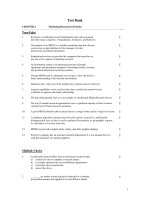Lecture Marketing research (12th edition) - Chapter 14: Sampling fundamentals
Bạn đang xem bản rút gọn của tài liệu. Xem và tải ngay bản đầy đủ của tài liệu tại đây (780.56 KB, 26 trang )
1
Marketing Research
Aaker, Kumar,
Leone and Day
Twelfth Edition
Instructor’s
2
2
Chapter Fourteen
Sampling Fundamentals
Marketing Research 12th Edition
3
3
Sampling Fundamentals
When is census appropriate?
•
•
•
•
Population size is quite small
Information is needed from every individual in
the population
Cost of making an incorrect decision is high
Sampling errors are high
Marketing Research 12th Edition
4
4
Sampling Fundamentals (Contd.)
When is sample appropriate?
•
•
•
•
•
•
Population size is large
Both cost and time associated with obtaining information
from the population is high
Quick decision is needed
To increase response quality since more time can be spent
on each interview
Population being dealt with is homogeneous
If census is impossible
Marketing Research 12th Edition
5
5
Error in Sampling
Total Error
▫ Difference between the true value and the observed
value of a variable
•
Sampling Error
▫ Error is due to sampling
•
Nonsampling Error
▫ Error is observed in both census and sample
Marketing Research 12th Edition
6
6
Error in Sampling (contd.)
Marketing Research 12th Edition
7
7
Sampling Process
Determining Target Population
•
•
•
•
•
•
•
Well thought out research objectives
Consider all alternatives
Know your market
Consider the appropriate sampling unit
Specify clearly what is excluded
Should be reproducible
Consider convenience
Marketing Research 12th Edition
8
8
Sampling Process (Contd.)
Determining Sampling Frame
•
•
List of population members used to obtain a sample
Issues:
▫
Obtaining appropriate lists
▫
Dealing with population sampling frame differences
Superset problem
Intersection problem
Selecting a Sampling Procedure
•
•
Choose between Bayesian and Traditional sampling procedure
Decide whether to sample with or without replacement
Marketing Research 12th Edition
9
9
The Sampling Process
Marketing Research 12th Edition
10
10
Sampling Techniques
Marketing Research 12th Edition
11
11
Types of Stratified Sampling
Proportionate Stratified Sampling
•
•
Number of objects/sampling units chosen from each group is
proportional to number in population
Can be classified as directly proportional or indirectly
proportional stratified sampling
Disproportionate Stratified Sampling
•
•
Sample size in each group is not proportional to the respective
group sizes
Used when multiple groups are compared and respective group
sizes are small
Marketing Research 12th Edition
12
12
Directly Proportional Stratified Sampling
Marketing Research 12th Edition
13
13
Inversely Proportional Stratified Sampling
q
q
q
Assume that among the 600 consumers in the population, 200 are heavy
drinkers and 400 are light drinkers.
If a research values the opinion of the heavy drinkers more than that of the
light drinkers, more people will have to be sampled from the heavy
drinkers group.
If a sample size of 60 is desired, a 10 percent inversely proportional
stratified sampling is employed.
The selection probabilities are computed as follows:
Denominator
600/200 + 600/400 = 3 + 1.5 = 4.5
Heavy Drinkers proportional and
sample size
3/ 4.5 = 0.667; 0.667 * 60 = 40
Light drinkers proportional and
sample size
1.5 / 4.5 = 0.333; 0.333 * 60 = 20
Marketing Research 12th Edition
14
14
Cluster Sampling
•
•
•
•
Involves dividing population into subgroups
Random sample of subgroups/clusters is
selected and all members of subgroups are
interviewed
Very cost effective
Useful when subgroups can be identified that
are representative of entire population
Marketing Research 12th Edition
15
Comparison of Stratified & Cluster Sampling Processes
Stratified sampling
Cluster sampling
Homogeneity within group
Homogeneity between groups
Heterogeneity between groups
Heterogeneity within groups
All groups are included
Random selection of groups
Sampling efficiency improved by
Sampling efficiency improved by
decreasing cost at a faster rate than
increasing accuracy at a faster rate than
accuracy.
cost
Marketing Research 12th Edition
16
16
Systematic Sampling
•
•
•
Involves systematically spreading the sample
through the list of population members
Commonly used in telephone surveys
Sampling efficiency depends on ordering of the
list in the sampling frame
Marketing Research 12th Edition
17
17
Non Probability Sampling
•
•
Costs and trouble of developing sampling
frame are eliminated
Results can contain hidden biases and
uncertainties
Used in:
•
•
•
•
•
The exploratory stages of a research project
Pretesting a questionnaire
Dealing with a homogeneous population
When a researcher lacks statistical knowledge
When operational ease is required
Marketing Research 12th Edition
18
18
Types of Non Probability Sampling
Marketing Research 12th Edition
19
19
Quota Sampling Example
Marketing Research 12th Edition
20
20
NonResponse Problems
•
Respondents may:
▫
▫
▫
•
•
•
Refuse to respond
Lack the ability to respond
Be inaccessible
Sample size has to be large enough to allow for non
response
Those who respond may differ from non respondents in
a meaningful way, creating biases
Seriousness of nonresponse bias depends on extent of
non response
Marketing Research 12th Edition
21
21
Solutions to Nonresponse Problem
•
•
•
Improve research design to reduce the
number of nonresponses
Repeat the contact one or more times (call
back) to try to reduce nonresponses
Attempt to estimate the nonresponse bias
Marketing Research 12th Edition
22
22
Shopping Center Sampling
•
•
20% of all questionnaires completed or
interviews granted are storeintercept
interviews
Bias is introduced by methods used to select
Marketing Research 12th Edition
23
23
Shopping Center Sampling (Contd.)
Solutions to Bias
•
Shopping Center Bias
▫
▫
•
Use several shopping centers in different neighborhoods
Use several diverse cities
Sample Locations Within a Center
▫
▫
▫
Stratify by entrance location
Take separate sample from each entrance
To obtain overall average, strata averages should be combined by
weighing them to reflect traffic that is associated with each
entrance
Marketing Research 12th Edition
24
24
Solutions to Bias (contd.)
•
Time Sampling
▫ Stratify by time segments
▫ Interview during each segment
▫ Final counts should be weighed according to traffic
counts
•
Sampling People versus Shopping Visits –
Options:
▫ Ask respondents how many times they visited the
shopping center during a specified time period,
such as the last four weeks and weight results
according to frequency
Marketing Research 12th Edition
25
25
Different Levels of Sampling
Frames
Marketing Research 12th Edition









